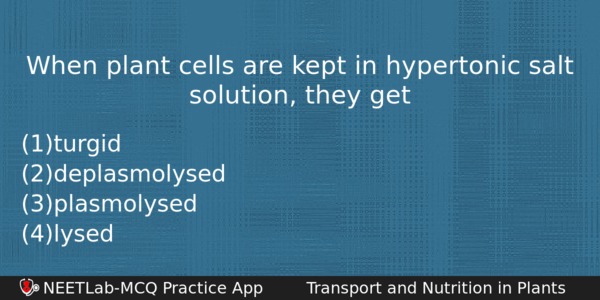| ⇦ | 
| ⇨ |
When plant cells are kept in hypertonic salt solution, they get
Options
(a) turgid
(b) deplasmolysed
(c) plasmolysed
(d) lysed
Correct Answer:
plasmolysed
Explanation:
Plasmolysis is the loss of water by osmosis from a plant cell to the extent that the cytoplasm shrinks away from the cell wall. This happens when the cell is placed in a hypertonic solution that has a higher solute concentration than that of the cell sap, i.e. solution has more negative water potential. Thus water will move from an area of high water potential to an area of low water potential.
Related Questions: - The maximum amount of electrolytes and water (70-80 %) from the glomerular
- Cirrhosis of the liver is caused by
- Cholera, leprosy and diphtheria are
- Which one of the following structures is an organelle within an organelle?
- Population exploiting a resource rapidly, and showing unbounding increase
Topics: Transport and Nutrition in Plants
(163)
Subject: Biology
(4253)
Important MCQs Based on Medical Entrance Examinations To Improve Your NEET Score
- The maximum amount of electrolytes and water (70-80 %) from the glomerular
- Cirrhosis of the liver is caused by
- Cholera, leprosy and diphtheria are
- Which one of the following structures is an organelle within an organelle?
- Population exploiting a resource rapidly, and showing unbounding increase
Topics: Transport and Nutrition in Plants (163)
Subject: Biology (4253)
Important MCQs Based on Medical Entrance Examinations To Improve Your NEET Score
18000+ students are using NEETLab to improve their score. What about you?
Solve Previous Year MCQs, Mock Tests, Topicwise Practice Tests, Identify Weak Topics, Formula Flash cards and much more is available in NEETLab Android App to improve your NEET score.
Share this page with your friends

Leave a Reply